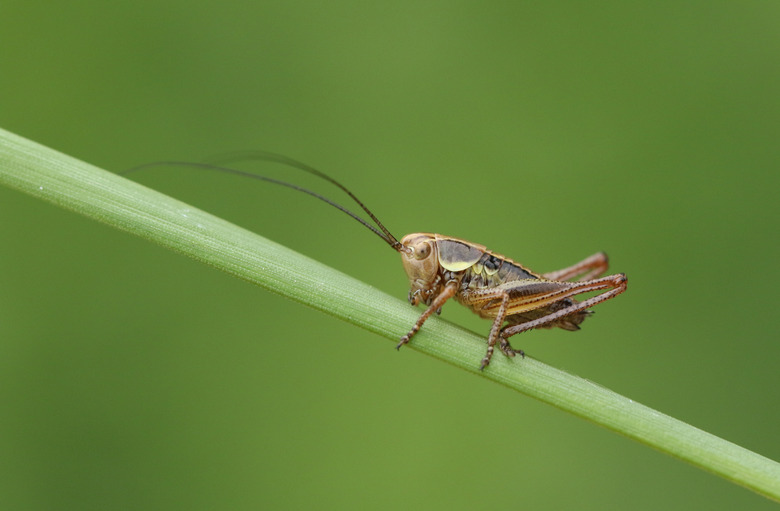How Do Crickets Go Into A Hibernation State When Cold?
Animals hibernate by slowing their metabolic rates to consume less energy during seasonal periods of food scarcity and extreme cold weather. Some animals, including crickets and many other invertebrates, actually go further by entering complete dormancy. In the process called diapause, every cell in a cricket's body ceases growth and the cricket enters a state of suspended animation. By completely shutting off its own biological processes, animals in diapause can survive extreme cold with no food or water at all, and some even survive being frozen.
Environmental Influence
Environmental Influence
Diapause is triggered by the environmental changes that precede winter. As summer wanes and fall approaches, the shorter periods of daylight trigger physiological changes which prepare the animal for diapause. Cooler temperatures may also trigger these changes.
Unseasonably warm temperatures may delay or prevent diapause in some species, which is why it is not unheard of for crickets to remain active in a basement throughout the winter. The abundance and quality of available food tend to diminish as winter approaches, providing further signals for diapause activation in crickets.
Lifespan and Life Stages
Lifespan and Life Stages
Many insects with a one-year life cycle have an obligatory diapause period, and will enter their dormant state during the appropriate life stage regardless of temperature or available daylight. The most common overwintering stage for crickets is the egg stage. Eighty percent of crickets overwinter as eggs, while only about 15 percent overwinter as nymphs and a small handful of species enter diapause as adults.
Crickets with a two-year life cycle differ in that they enter diapause during two different stages. Which two stages enter dormancy varies among cricket species. For example, crickets in the British Isles overwinter during their egg and nymph phases, while a cricket species in northern Japan overwinters first as a nymph and then as an adult prior to reproduction.
Hormonal and Chemical Assistance
Hormonal and Chemical Assistance
The physiological changes triggered by environmental cues are regulated by hormonal activity. Insect endocrine glands secrete hormones such as ecdysone and juvenile hormone that regulate insect growth and molting. The production and termination of these secretions helps determine when, and at what stage of development, the cricket enters diapause. This endocrine control of diapause varies by species.
Some insects survive freezing temperatures through biochemical means, that is, they create their own antifreeze. Freeze tolerance or freeze avoidance is possible with the help of cryoprotectant molecules. Sugars, such as trehalose, and amino acids, such as proline, within the insect's tissue and haemolymph (blood) act to protect the insect from freezing. While more study is needed in this area, crickets do exhibit the ability to tolerate freezing with the presence of these biochemicals.
Evolution of Diapause
Evolution of Diapause
Crickets have difficulty surviving if their dormant periods do not align with the onset of winter, so natural selection hinders radical deviation and encourages successive generations whose rhythms conform to the environment. In temperate climates, where the length and severity of seasons varies widely across a range of latitudes, speciation occurs by virtue of when and how long crickets are affected by seasonal change. Comparable cricket populations in warmer, tropical climates do not exhibit this tendency toward speciation, as there is no winter to trigger divergence in developmental rhythms.
Ideal Conditions
Ideal Conditions
Unstable temperatures may interfere with a cricket's dormant period. A sudden but brief thaw can rouse dormant crickets, but they are unlikely to survive a refreeze. While some cricket species can survive being frozen solid and emerge from diapause unscathed in the spring, others find survival easier by going dormant in a sheltered micro-habitat. A dormant period spent underground or inside the wood of logs may provide a buffer against temperature fluctuations, and ensure that diapause continues until spring.
Cite This Article
MLA
Callahan, Rob. "How Do Crickets Go Into A Hibernation State When Cold?" sciencing.com, https://www.sciencing.com/crickets-hibernation-state-cold-12051048/. 30 September 2021.
APA
Callahan, Rob. (2021, September 30). How Do Crickets Go Into A Hibernation State When Cold?. sciencing.com. Retrieved from https://www.sciencing.com/crickets-hibernation-state-cold-12051048/
Chicago
Callahan, Rob. How Do Crickets Go Into A Hibernation State When Cold? last modified August 30, 2022. https://www.sciencing.com/crickets-hibernation-state-cold-12051048/
